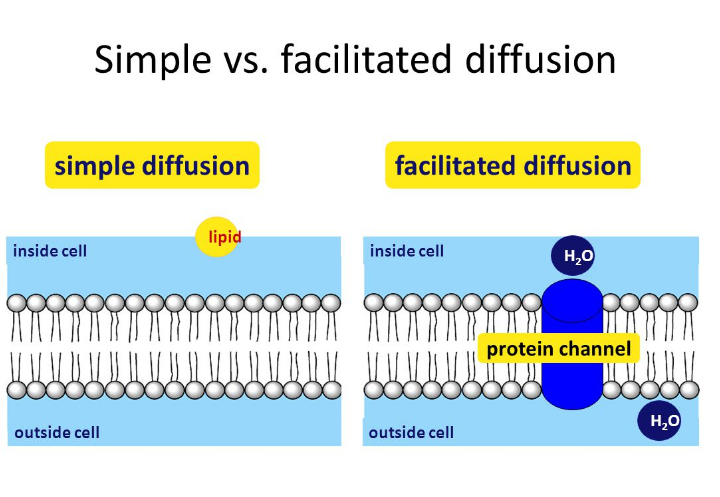What Is Meant By Facilitated Diffusion?
Facilitated diffusion also referred to as facilitated transport or passive-mediated transport can be described as passive movement of molecules across the cell membrane through a concentration gradient by means of a carrier molecule (membrane protein). This process is mediated by two distinct types of transport proteins-channel proteins and carrier proteins.
Facilitated diffusion does not directly involve high-energy molecules like Adenosine Triphosphate (ATP) or Guasosine Triphosphate (GTP) since the molecules are moving along their concentration gradient. Examples of facilitated diffusion include:
- Co-transport of sodium together with glucose, galactose, fructose, amino acids.
- The counter-transport of chloride/bicarbonate in renal tubular cells.
What Is Simple Diffusion?
Simple diffusion is the process by which solutes are moved along a concentration gradient in a solution or across a semipermiable membrane. Simple diffusion is carried out by the actions of hydrogen bonds forming between water molecules and solutes. The rate of simple diffusion is affected by properties of the cell, the size of diffusing molecules and the surrounding solution. Examples of simple diffusion include:
- Diffusion of gasses across the respiratory membrane.
- Diffusion of molecules from the blood to cells through interstitial fluid.

Also Read: Difference Between Diffusion And Osmosis
Facilitated Vs Simple Diffusion In Tabular Form
| BASIS OF COMPARISON | FACILITATED DIFFUSION | SIMPLE DIFFUSION |
| Description | Facilitated diffusion entails movement of substances across a biological membrane through a concentration gradient by means of a carrier molecule. | Simple diffusion entails movement of particles from a region of high concentration to a region of low concentration across a membrane without the assistance of carrier molecules. |
| Inhibition | Facilitated diffusion can be inhibited by specific inhibitor which binds to the carrier molecules. | No inhibitor molecule can inhibit the process of simple diffusion. |
| ATP Requirement | Facilitated diffusion may or may not require energy from ATP. | Simple diffusion does not require energy from ATP. |
| Molecules | Through facilitated diffusion large or polar particles are transported across the plasma membrane. | Through simple diffusion small, non-polar molecules are passed through a plasma membrane. |
| Occurrence | Facilitated diffusion occurs through specific facilitator molecules referred to as trans-membrane integral proteins. | Simple diffusion occurs directly through the cell membrane. |
| Rate of Diffusion At Low Concentration Gradient | At low solute concentration, the rate of facilitated diffusion is relatively high when compared to that of simple diffusion. | At low solute concentration, the rate of simple diffusion is relatively low when compared to that of facilitated diffusion. |
| Specificity | Facilitated diffusion is always solute specific. | Simple diffusion is not solute specific. |
| Factors Affecting The Rate of Diffusion | The rate of facilitated diffusion depends on the kinetics of carrier-mediated transport. | The rate of simple diffusion depends on the membrane permeability, size of molecules and the concentration gradient across the membrane. |
| Kind Of Process | Facilitated diffusion can be active or a passive process. | Simple diffusion is normally passive. |
| Type Of Membrane | Facilitated diffusion takes place through trans-membrane proteins. | Simple diffusion takes place through the phospholipid bilayer. |
| Examples | Co-transport of sodium together with glucose, galactose, fructose, amino acids.The counter-transport of chloride/bicarbonate in renal tubular cells. | Diffusion of gasses across the respiratory membrane.Diffusion of molecules from the blood to cells through interstitial fluid. |
Also Read: Difference Between Diffusion And Imbibition
What Are Some Of The Similarities Between Simple And Facilitated Diffusion
- Both facilitated and simple diffusion do not necessarily require energy.
- In both facilitated and simple diffusion, molecules move from a region of high concentration to a region of low concentration.